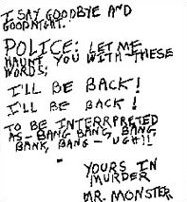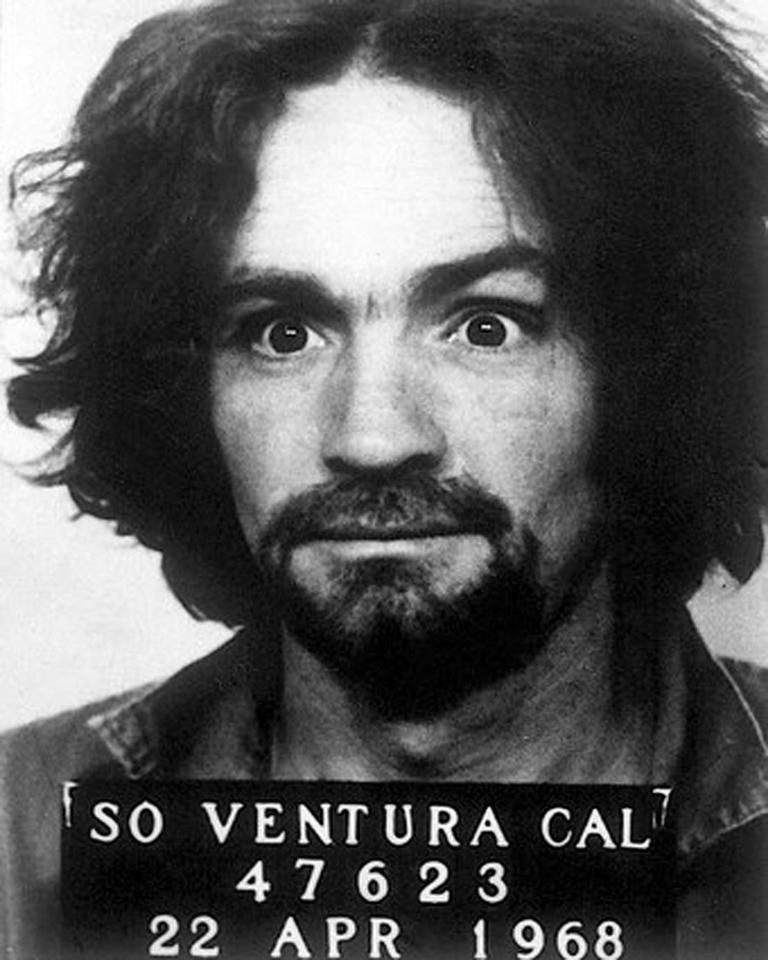Serial killers, who have plagued our streets and our headlines, have always been a subject of both curiosity and fear. Though the motives of serial killers are as various as their grisly crimes, we can begin to understand the inner workings of their minds by evaluating the words they have left behind.
◊
Psychopath, Killer, Monster. These words are associated with some of the most horrifying names in American history, and I’m not talking about on the big screen. I’m talking about the real-life Hannibal Lectors, Jasons, and Freddies: Ted Bundy, Jeffrey Dahmer, Son of Sam, Charles Manson, and their ilk.
What pushed these men to succumb to their wretched urges, and what drove them to live out the horrors most mere mortals only read about? Were these inborn behaviors or ones facilitated by – or learned from – wicked pasts? Whatever the motivation, it’s safe to say these killers’ behaviors are taboo, albeit intriguing. Many psychologists – along with the general public – are curious to discover what makes serial killers tick.
While you may not be able to sit down with any of these nefarious villains (even if you dared), analyzing some of their bone-chilling quotes just might reveal the secrets of their twisted minds – and perhaps the darkest recesses of the human psyche.

Ted Bundy (Source: Donn Dughi / State Archives of Florida, Florida Memory, via Wikimedia Commons)
Ted Bundy
“Murder is not about lust and it’s not about violence. It’s about possession.”
Theodore “Ted” Bundy was known as a charming and intelligent man, though he had a much darker side he kept hidden behind closed doors. A four-year span from 1974 to his final arrest in 1978 was marked by a trail of blood – a trail that followed Bundy cross-country from coast to coast. Bundy used his charm to deceive and trap women. Once captured, Bundy would brutally rape and murder his victims, and was known to continue the mutilation post-mortem. But what accounts for his compulsion to possess women so mercilessly? Ultimate power.
“You feel the last bit of breath leaving their body. You’re looking into their eyes. A person in that situation is God!”
Serial killers are classified into several categories, and Bundy’s words and actions indicate that he is a Power-Seeker Serial Killer. Many of Bundy’s explanations for his behavior revolve around his desire and urge for power, as is typical with murderers in this category. They share an ultimate goal of complete control over the life and death of others. It’s evident that Bundy not only wanted to decide his victim’s fate, he needed to – he deeply needed to have the power of a god, perhaps to compensate for a power he lacked. It’s believed that his victims may have shared physical characteristics resembling those of an ex-girlfriend, and that he may have used his victims as surrogates in order to avenge and have control over the woman he couldn’t keep.
Throughout his multi-year rampage, Bundy terrorized countless victims. Once finally captured and tried for his crimes, he was sentenced to death and lived in Florida State Prison until his execution by electric chair on Jan. 24, 1989. Bundy confessed to committing 30 murders over a four-year span, but investigators believe his death toll far surpassed 100.

Jeffrey Dahmer in high school (Source: Revere Senior High School, Public Domain, via Wikimedia Commons)
Jeffrey Dahmer
“My consuming lust was to experience their bodies. I viewed them as objects, as strangers. It is hard for me to believe a human being could have done what I’ve done.”
From 1978 to 1991, Wisconsinite Jeffrey Dahmer raped and murdered 17 men and boys, dismembering and allegedly eating their bodies, and often performing acts of necrophilia before cannibalizing them. Dahmer hunted for men at gay bars and other public venues, and would lure his targets to his home by seduction or promises of money.
“It’s a process, it doesn’t happen overnight, when you depersonalize another person and view them as just an object … an object for pleasure and not a living breathing human being.”
Another category of serial killer is the Hedonistic Killer. This butcher gains pleasure from the act of murder itself. To these individuals, people are merely objects used for amusement, and their drive comes from lust, thrill, or comfort. For Dahmer, each slaughter brought a rush – a lustful experience in which he could achieve sexual release. His words and actions clearly set him apart as a hedonistic murderer for whom satisfaction is a fleeting emotion and killing is habitual. These villains are forever chasing pleasure and release.
“I was completely swept along with my own compulsion. I don’t know how else to put it. It didn’t satisfy me completely, so maybe I was thinking, ‘Maybe another one will. Maybe this one will.’ And the numbers started growing and growing and just got out of control, as you can see."
Dahmer was finally put to a stop one fateful day in July 1991, when officers found his apartment full of photographic evidence, weapons, and dismembered body parts. Dahmer was arrested that day, and was eventually sentenced to 16 life terms. He was imprisoned at the Columbia Correctional Institution, where he was killed by fellow inmate Christopher Scarver in 1994.

Second page of first Son of Sam letter, written by David Berkowitz (Source: Public Domain, via Wikimedia Commons)
David Berkowitz – “Son of Sam”
“A ‘possessed’ dog in the neighborhood won’t let me stop killing until he gets his fill of blood.”
In a span of one year, from 1976 to 1977, David Berkowitz – commonly known as the "Son of Sam" – terrorized the streets of New York City. Armed with experience in the U.S. Army and plagued by a troubled childhood, Berkowitz murdered six random people and left taunting letters for the police along the way. He claimed his neighbor, Sam Carr, passed along instructions for the killings via his demon-possessed dog, Harvey.
“I was literally singing to myself on my way home, after the killing. The tension, the desire to kill a woman, had built up in such explosive proportions that when I finally pulled the trigger, all the pressures, all the tensions, all the hatred, had just vanished, dissipated, but only for a short time.”
Visibly delusional, Berkowitz was psychotic and was driven by his hallucinations, which is typical of a Visionary Killer. These murderers are driven by messages often thought to come from either God or demons. Often, as with Berkowitz’s pattern, victims of this kind of murderer are not targeted. Instead, they are selected out of convenience or proximity. Through his own words, Berkowitz demonstrated that he himself was not in control of the killings. Rather, he was possessed, and he gained no release from killing outside of the act itself. After committing a murder, a calm would wash over Berkowitz, and he would experience a temporary return to reality…until the next “message” arrived.
“I didn’t want to hurt them, I only wanted to kill them.”
After his final attempted murder, Berkowitz was discovered by police. The judge in his case sentenced him to 25 years to life for each of the six murders he committed. He is currently serving his sentence in Shawangunk Correctional Facility in Wallkill, NY, where there have been no reports of messages from Sam or Harvey.

Charles Manson mug shot, 1968 (Source: California Department of Corrections and Rehabilitation, via Wikimedia Commons)
Charles Manson and “The Family”
Charles Manson is arguably the most infamous of the killers examined here. Although Manson claimed none of the murders were committed by his own hands, the killings and motivation behind them still earn him the Mission-Oriented Killer classification. Mission-Oriented Killers are rarely perceived as psychotic, but they usually feel mandated by God. Manson claimed he was God’s son and envisioned a race war – a war he was “prophesied” to lead – that would kick off the start of a new world.
“Look down on me, you will see a fool.”
Manson managed to captivate a group of minds and put them under his spell with his fantastical ideas and mesmerizing allure. He led his followers to commit one of the most infamous cases of Disciple Killing: the murder of actress Sharon Tate and others on August 8–9, 1969, in her Los Angeles home. As is typical of Disciple Killings, the actual murders are committed by others at the behest of a charismatic leader. The “followers” seek psychological rewards of acceptance from their leader without consideration of consequences. These followers are used as “weapons” – usually void of personal interest in the murders aside from the desire to please their leader.
“Look up at me, you will see your Lord.”
Using his charm, Manson accumulated a following, which he dubbed “the family.” Fixating on the title of a Beatles song, he preached “Helter Skelter,” in which he proclaimed that the whole world was coming to a crossroad, and that life, as they knew it, would be over. He recruited three of his followers – Susan Atkins, Patricia Krenwinkel, and Linda Kasabian – to accompany Charles “Tex” Watson on a mission: create a bloodbath at the former home of music producer Terry Melcher, who had denied Manson a recording contract. The crime was to be so gruesome that it would set Helter Skelter in motion. As it happened, Sharon Tate and her husband Roman Polanski (who has some dark secrets of his own [1]) had recently rented the house, and Tate was brutally murdered along with friends that fateful night. The house was left in a horrific state, the walls dripping with bloody messages.
“Look straight at me, you will see yourself.”
Manson’s mission was eventually thwarted, and he was sentenced to multiple life terms. Though he maintained his innocence on the grounds that he was not physically present for any of the murders, he was convicted under the joint-responsibility rule. He served out his sentence at California State Prison in Corcoran, and died on Nov. 19, 2017.
Monsters on the Loose
From talking dogs to throngs of followers, the motivations of these American monsters may have differed, but their actions haunt our dreams. While the killers quoted here can do no more harm, they’re only a tiny fraction of those who are still on the loose. Chillingly, it is believed that there may be as many as 2,000 serial killers at large in the United States today. [2] And we are left to wonder what turned these humans into real-life monsters that inhabit our nightmares. Would we really sleep better if we knew whether nature or nurture is to blame?
Ω
Title image: Dangerous hooded man holding knife. (Credit: ijdema, via Adobe Stock)

